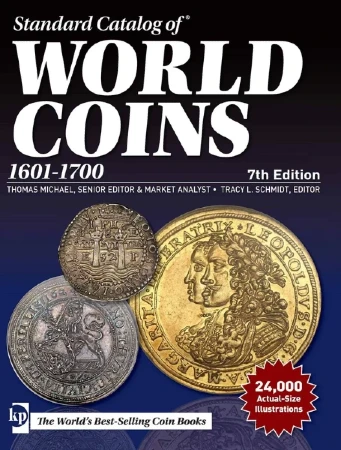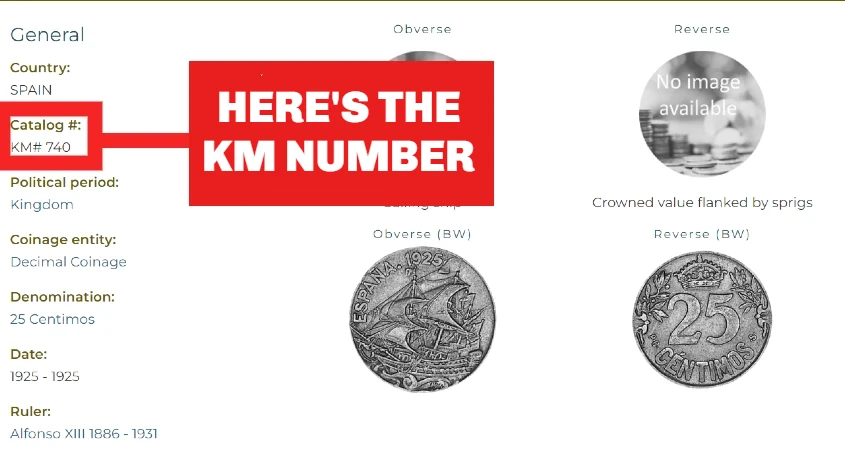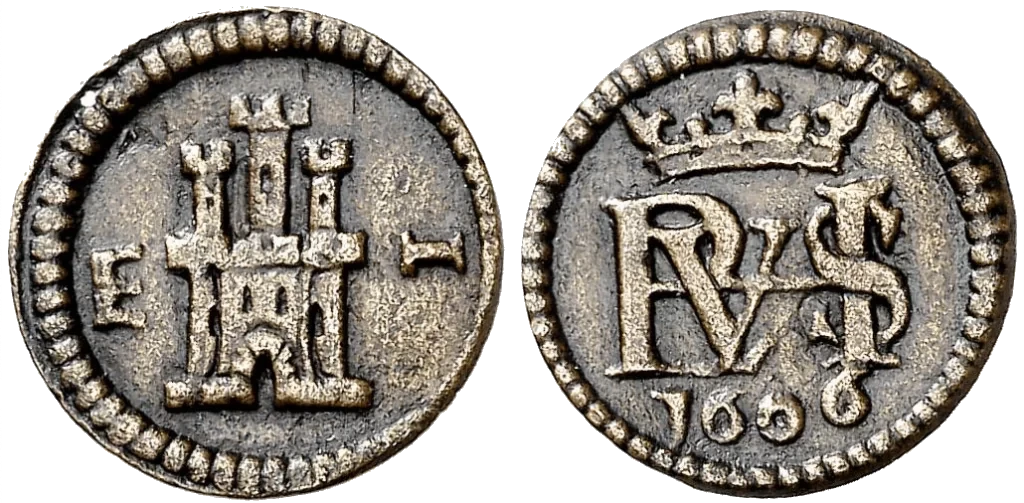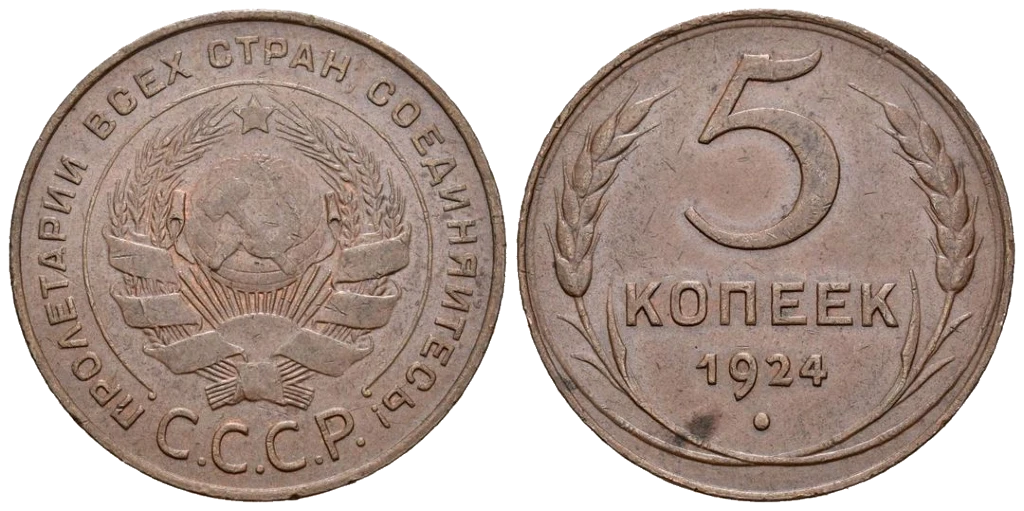If there’s one thing about numismatics, it’s the vast amount of specialized terminology that can be hard to grasp when you’re starting in the field. So, little by little, we’re going to look at the meaning of those words. Today, it’s time to see what the KM number of a coin is, who decides it, and how and where to find it.
The KM number, of a coin (an acronym for Krause-Mishler) is a code belonging to the world coin classification system originally established in the various volumes of the Standard Catalog of World Coins, the so-called “Krause Catalogs”, and which today is published on the Numismaster website. Each type of coin has its own number, and the numbers for each country start with KM#1.
The Standard Catalog of World Coins (and its demise)
If you go to any entry in the ColeMone Spanish language 2 euro coin catalog catalog, you’ll see one of the basic data points shown there is the coin’s KM number. For example, the 2010 Germany 2 euro commemorative coin is KM#285.
Or, if you go to many coins auctioned at Heritage, it will also appear. Any from, say, Tauler&Fau, and there it is again. And I could continue with many of the most prestigious auction houses, and follow up with the less prestigious ones.
That’s because the KM number is the global standard for classifying world coins issued since the 16th century. Almost all professionals and collectors use that code, usually supplemented with a national catalog’s, like the CJ in Argentina or the Red Book in the US.

From its establishment in 1972 until its last edition in 2019, the KM was featured in the Standard Catalog of World Coins, published by F+W Media through its Krause Publications imprint.
The Standard Catalog is divided into 5 volumes, ranging between 1600 and 2500 pages each, covering roughly a century of world coins. The volumes that cover the 20th and 21st centuries were updated annually, while the books covering earlier centuries had a slower and more irregular publication pace.
The Death of the Standard Catalog
However, since the fall of 2019, no new edition of any of the 5 volumes has been published, and there seems to be no plans to continue doing so.
The reason for this is that, in March of that year, F+W Media declared bankruptcy.
This bankruptcy, truth be told, was foreseeable. In the last two or three years, the pace of assigning KM numbers had dropped significantly, with delays of 4 or 5 years from the issuance of the coin to the assignment of its number, especially in smaller countries. This happened for two reasons:
1- On the way to bankruptcy, there were layoffs at the company. With fewer employees, it was necessary to prioritize the assignment of codes, with the larger countries and those with more catalog sales going first, especially Germany, Italy, the United Kingdom, Canada, and the United States. And, after those, they’d work on whatever coins there was time for.
2- Before the financial problems, Krause had collaborators all over the world, who, although they were not part of the salaried staff, contributed a lot to the cataloging process. I’m not exactly sure why, whether by the collaborators’ decision or the company’s, but many of them had reduced their contributions or had directly stopped contributing.

The bankruptcy declaration by F+W was accompanied by a court order to auction off the company’s assets to pay off debts.
And the entire F+W book division, including the Krause Publications imprint, was bought by Penguin Random House, one of the largest publishers in the world. Meanwhile, the numismatic magazines (along with other collectibles magazines) were acquired by a small Colorado publisher called Active Interest Media, which would eventually also purchase Krause Publications from Penguin, thus taking over F+W’s entire numismatic segment.
Since then, there has not been a physical edition of the Standard Catalog. But that does not mean that the KM Code is dead.
Where and How to Look Up the KM of a Coin: Numismaster
Aware of the worldwide importance of KM Codes, Active Interest Media has decided to adapt them to the 21st century and transition them from paper to digital.
This is how Numismaster was born, a website that serves as a database intended to replace the original catalogs and that, in addition to the KM numbers, also includes Pick numbers, the equivalent for banknotes.
On Numismaster, you can view the KM codes for free, and they are updated quite often. However, if you want to know the values, which was the other major contribution of the physical catalogs, you will have to pay for a subscription that will cost you between $7.50 and $15 per month, depending on the level of access you want.
But let’s be honest, Numismaster is neither a pretty website to look at nor easy to use. So allow me to write a short tutorial on how to look up the KM of a coin there:
Step 1: Search
More or less in the center of the screen, you will see a box that says “Search coins…”. Type the details of your coin there. My recommendation is to write the name of the country in English, the denomination as it appears on the coin, and the year, and then hit the “Search” button.
Let’s use as an example the Spanish 25 cents from 1925, nicknamed “La Caraba”:

Step 2: Select
After waiting a bit while the system searches for results, a new screen will appear with a list of coins that might match what you’re looking for. Click on the one you want to know more about.
If the list is very large, you can filter by country or metal. However, if you search as I instructed above, this will almost always be unnecessary, as you can see in my example search.

Step 3: Verify
After clicking on your coin in the list, Numismaster will take you to its individual record. In the right-hand column, you will finally be able to see the KM.

If you continue scrolling down the screen, you will see more data in the right-hand column, as well as the values in several conservation grades (if you have a subscription) and other related coins.
And now that we know where to look up the KM and who assigns it, there’s one last thing to find out: how it is assigned.
How is the KM Number of a Coin Assigned?
The specific algorithm by which a KM number is assigned to a coin is proprietary, and therefore secret, but we do know that it has barely changed in the transition from paper to digital. And after so many years of using these catalogs to classify their pieces, collectors have been able to identify certain patterns that have been repeated over time.
The KM number is unique for each country. Within each country, coins are sorted by type and not by year, first from oldest to newest, and then from lowest to highest denomination.

When the design of a coin changes in a significant way, a new KM number is assigned to the piece. If the variation is minor, then a sub-number is added, separated by a dot.
For example, the Spanish 1 maravedí coin that you can see in the photo above can be found with two mint marks: Cuenca and Segovia. As the variation in design caused by the different mint marks is not very significant, those minted in Cuenca are KM#1.1, and those minted in Segovia are KM#1.2.
If there are two pieces with the same design but the coin’s metal changes, then a letter is added to the end of the KM number.
As an example, Germany changed the material of the 2 pfennig coin in 1967. It went from being made of bronze to being made of copper-coated steel. The bronze ones are KM#106, and the copper-coated steel ones are KM#106a.
It’s also possible that a coin does not have a KM number assigned to it. This usually happens for two reasons: either the authors have not gotten to it yet, or it is not a real coin and rather belongs to the field of exonumia.
C# or Y# Numbers
Or it might be that instead of a KM, there’s a Y# or C# number, as it happens with the Russian coins.
The reason for this change is that the Krause catalogs incorporate, for certain countries, the classification works of previous authors. The “Y” corresponds to Richard S. Yeoman, and the “C”, to George Cuhaj. Maintaining these codes is a way to credit the original author’s contribution and, at the same time, to honor them.

In the end, the KM number is not strictly necessary to enjoy the hobby and your collection. But it is so prevalent and so widely used that it’s very convenient, at the very least, to know what it is.